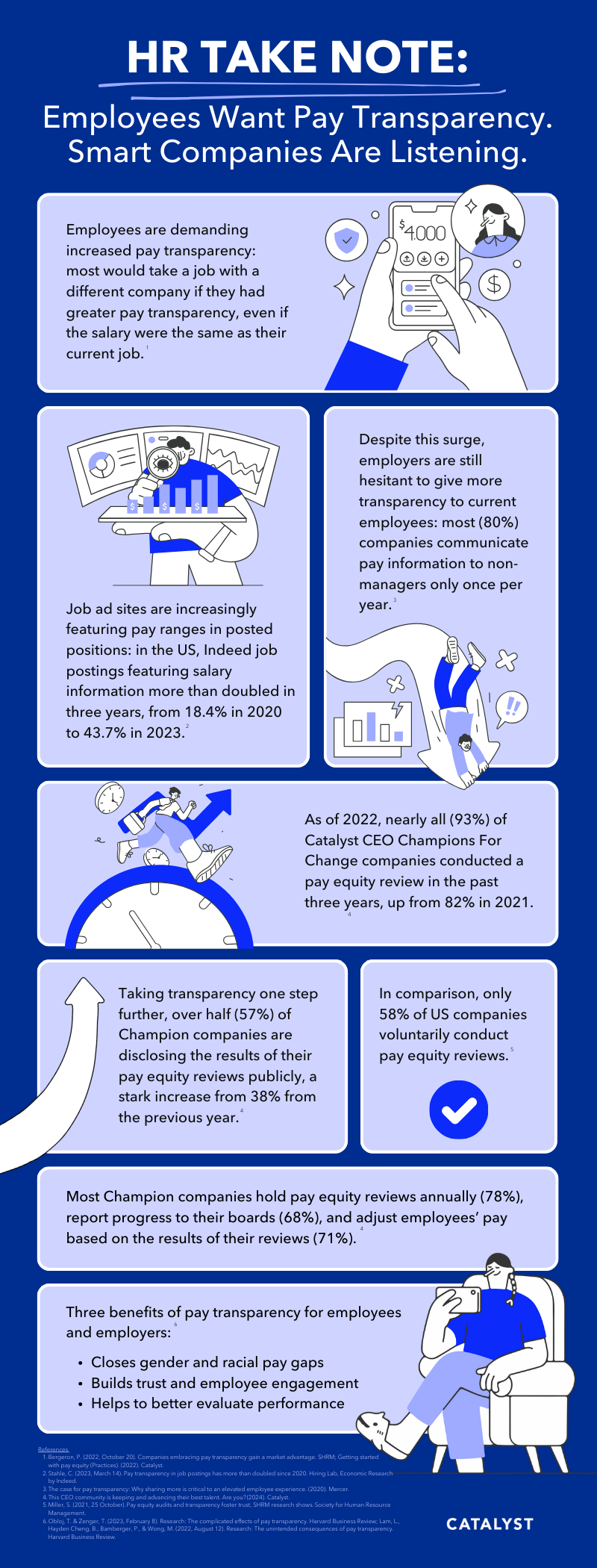
How much do you earn? For some of us, pay is deeply personal and emotional, even too socially taboo to talk about. That money mindset is shifting thanks to pay transparency. It’s now normal for job sites like LinkedIn and Indeed to feature salary ranges for many open positions.1
Employees expect a high degree of transparency from their employers, particularly when it comes to pay.2 In fact, most employees would take a job with a different company if they had greater pay transparency, even if the salary were the same as their current salary.3
Laws are changing, too. Pay transparency laws are evolving across the world; for example, Canada and the United Kingdom already require eligible employers to annually disclose pay information by gender.4 Meanwhile, in the US, several states and cities are enacting laws that require employers to disclose salary ranges to job applicants in job postings, during the hiring process, or upon request.5
Pay transparency is the degree to which an employer is open about sharing pay-related information.6 There are three types of pay transparency: outcome transparency (pay in actual numbers, like levels or ranges), process transparency (such as criteria for determining pay), and communication transparency (freely sharing pay-related information with employees and job candidates).7What is pay equity? Pay equity is often referred to as “equal pay for equal work,” and is the practice of paying people the same for providing the same or similar work, skills, and value, while accounting for non-discriminatory factors like location. Pay equity reviews involve a rigorous analysis of workforce and compensation data to find gaps—and, in some cases, root causes of disparities—and the implementation of accountability mechanisms to remediate gaps. Successful pay equity initiatives are built from organizational trust, transparency, and accountability.8
Pay equity is now standard practice among leading organizations.
The rise of pay transparency is laying the foundation for fairer corporate decisions and processes—including pay equity. The Catalyst CEO Champions For Change, a community of global business leaders committed to advancing women across racial and ethnic groups into leadership roles and onto boards of directors, are proving that pay equity is no longer a “nice to have;” it’s table stakes. As of 2022, nearly all (93%) of Champion companies conducted a pay equity review in the past three years, up from 82% in 2021. Taking transparency one step further, over half (57%) of Champion companies are disclosing the results of their pay equity reviews publicly, a dramatic increase from 38% from the previous year. True to their commitment, this community models accountability by holding regular pay equity reviews (78% do so annually), reporting their progress to their boards (68%), and adjusting employees’ pay based on the results of their reviews (71%). Given their investment in fair and equitable organizational processes, it’s no wonder that Champion companies consistently outperform their peers in women’s representation across the leadership pipeline and are retaining women and men at similar rates across job levels.9
The Opportunity: Even when not legally required to be transparent about pay, companies should disclose salary information both publicly and internally. While companies are increasingly adopting pay transparency norms, there is an opportunity for more to extend this transparency to existing employees: about 80% of companies communicate pay information to non-managers once per year.10
Pay transparency is a competitive differentiator.
Pay transparency and pay equity are powerful tools for closing gender wage gaps and reap numerous benefits to employees and workplaces. Research from across the world has linked pay transparency with reducing, or in some cases eliminating entirely, pay inequities across gender, ethnicity, sexual orientation, and other dimensions of diversity.11 As pay transparency laws spread across the United States, HR leaders interested in attracting and retaining women should note that pay transparency is top of mind particularly for women, and especially women of marginalized racial and ethnic groups, who have long felt the economic impacts of unequal pay.12
Pay transparency builds trust, boosts employee engagement, and cultivates a positive work environment.13 Adopting pay transparency practices can also offer companies a competitive edge and save on recruitment costs.14
The Opportunity: Organizations committed to closing the pay gap should also eliminate salary history questions and restrict salary negotiations to the pay ranges already communicated to job candidates. Relying on salary history and negotiations disadvantages women and candidates of marginalized racial and ethnic groups.15
Critically, pay transparency can help companies better understand how to evaluate performance. As pay structures and decisions become clearer, employers can determine when they are overly emphasizing easily observable measures of performance (such as the bottom line and profit and loss) and overlook those that are less easily observable (such as team citizenship behaviors or the impact of mentoring).16
Don’t let fear determine your pay strategy.
Despite these benefits, many organizations fear potentially negative impacts of pay transparency and pay equity. Some might ask: Will we anger employees if longstanding pay discrepancies or outdated pay practices are revealed?17 But simply avoiding pay transparency and pay equity does not mean that a company pays all employees fairly; it just means that inequities may be hidden from view. In fact, in the absence of having these tools at their disposal, employees often make incorrect assumptions about their colleagues’ earnings based on other pieces of information, feeding biases and discontent.18
It’s time to invest in pay transparency.
Pay transparency and pay equity initiatives succeed when organizations clearly define their pay philosophy, objectively assess performance, consistently communicate differences in pay and the decisions behind them and commit to ongoing measurement and accountability. 19
If your organization chooses to remain opaque when it comes to pay, it risks diminishing employee trust and satisfaction, losing out on the benefits of fairer and more consistent business practices, and tarnishing its brand reputation as out-of-step with leading practices—and it may even be out of compliance with local and national laws.20 Clearly, pay transparency and pay equity are not only critical for closing the gender pay gap; they are also proven strategies for transforming business and talent processes.
Stay tuned for Part 2 to get practical tips on how your organization can get started with pay transparency.

ENDNOTES
Brown, H.C. (2023, June 20). A job with a fair salary? What pay transparency laws are revealing. The New York Times.
Alpaio, K. (2023, January 23). How salary transparency can help you (and your workplace). Harvard Business Review.
Bergeron, P. (2022, October 20). Companies embracing pay transparency gain a market advantage. SHRM.
Monsma, L., VanDerMeulen, J., & Arseneault, S. (2023, March 30). Pay transparency: A growing trend. Fasken; Benedi Lahuerta, S., Rejchrt, P., & Patrick, A. (2023). The UK pay transparency regulations: Apparent transparency without accountability? Legal Studies, 1.24.
Marfice, C. (2024). Pay transparency laws: A state-by-state guide. Rippling
The case for pay transparency: Why sharing more is critical to an elevated employee experience. (2020) Mercer.
Bamberger, P. (2021). Pay transparency: Conceptualization and implications for employees, employers, and society as a whole.. In Bergh, D. (Ed.), The Oxford Research Encyclopedia (ORE) of Business and Management. Oxford University Press; Lam, L., Hayden Cheng, B., Bamberger, P., & Wong, M. (2022, August 12). Research: The unintended consequences of pay transparency. Harvard Business Review.
Getting started with pay equity (Practices). 2022 Catalyst.
This CEO community is keeping and advancing their best talent. Are you?. 2024 Catalyst.
Pay transparency study. (2020). WorldAtWork and Mercer.
Obloj, T. & Zenger, T. (2023, February 8). Research: The complicated effects of pay transparency. Harvard Business Review.
Kim, D.H. (2023). Pay range transparency helps reduce gender wage gaps. National Women’s Law Center.
Lam, L., Hayden Cheng, B., Bamberger, P., & Wong, M. (2022, August 12). Research: The unintended consequences of pay transparency. Harvard Business Review.
Maurer, R. (2022, December 12). Study: Pay transparency reduces recruiting costs. SHRM.
Gallo, A. (2020, August 4). Don’t ask job candidates for a salary history. Harvard Business Review;; Superville, D. (2024, January 29). Biden is marking the 15th anniversary of landmark pay equity law with steps to help federal workers. Associated Press; Exley, C., Nierderle, M., & Vesterlund, L. (2016, April 12). New research: Women who don’t negotiate might have a good reason. Harvard Business Review; Christie, B. (2023, April 21). Salary negotiations could become moot point with pay transparency. WorldAtWork.
Obloj, T. & Zenger, T. (2023, February 8). Research: The complicated effects of pay transparency. Harvard Business Review.
Researchers have found that employee responses to pay transparency vary depending on what it uncovers about an organization’s pay practices. For example, employee productivity may increase if pay transparency shows that an employer has been consistent and fair in assigning pay based on performance. When pay transparency reveals discriminatory pay practices, employee productivity is more likely to decrease. Additionally, some studies suggest that pay transparency lowers overall wages of employees, since employers are less likely to negotiate salaries with candidates or current employees. Reduced employee bargaining power may cause star performers to leave for organizations that pay more – which organizations then try to offset by offering additional perks and bonuses, which undermines both pay transparency and pay equity. Obloj, T. & Zenger, T. (2023, February 8). Research: The complicated effects of pay transparency. Harvard Business Review; Kessler, S. (2023, January 14). Who benefits when salary info is public? The New York Times; Bamberger, P. (2021). Pay transparency: Conceptualization and implications for employees, employers, and society as a whole. In Bergh, D. (Ed.), The Oxford Research Encyclopedia (ORE) of Business and Management. Oxford University Press.
Alpaio, K. (2023, January 23). How salary transparency can help you (and your workplace). Harvard Business Review.
Kessler, S. (2023, January 14). Who benefits when salary info is public? The New York Times.
To learn more about pay transparency and pay equity laws in the United States, Canada, and the EU, respectively, see: Marfice, C. (2024). Pay transparency laws: A state-by-state guide. Rippling; Monsma, L., VanDerMeulen, J., & Arseneault, S. (2023, March 30). Pay transparency: A growing trend. Fasken; Pay transparency in the EU. (2023). European Council and Council of the European Union.
INFOGRAPHIC ENDNOTES
Bergeron, P. (2022, October 20). Companies embracing pay transparency gain a market advantage. SHRM; Getting started with pay equity (Practices). (2022). Catalyst.
Stahle, C. (2023, March 14). Pay transparency in job postings has more than doubled since 2020. Hiring Lab, Economic Research by Indeed.
The case for pay transparency: Why sharing more is critical to an elevated employee experience. (2020). Mercer.
This CEO community is keeping and advancing their best talent. Are you? (2024). Catalyst.
Miller, S. (2021, 25 October). Pay equity audits and transparency foster trust, SHRM research shows. Society for Human Resource Management.
Obloj, T. & Zenger, T. (2023, February 8). Research: The complicated effects of pay transparency. Harvard Business Review; Lam, L., Hayden Cheng, B., Bamberger, P., & Wong, M. (2022, August 12). Research: The unintended consequences of pay transparency. Harvard Business Review.




![What Is An Alternative Education Program? Preparing Students For The Future [2024 DEI Resources]](https://diversity.social/wp-content/uploads/2023/01/Best-employers-for-Family-friendly-diversity-certification.png)
